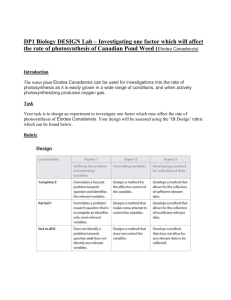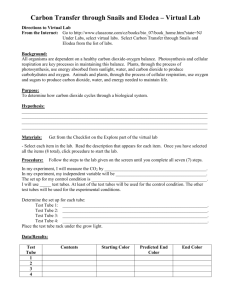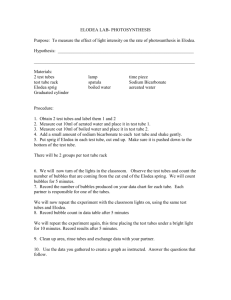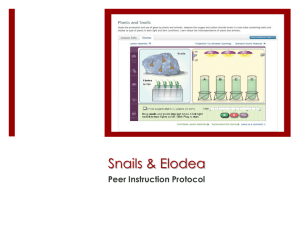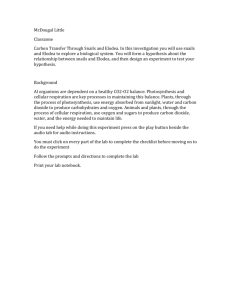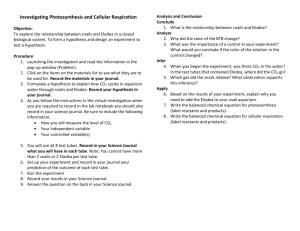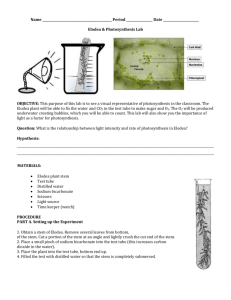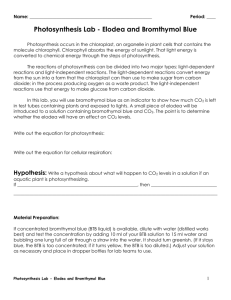Inhibitors of Photosynthesis in Aquatic Plants
advertisement
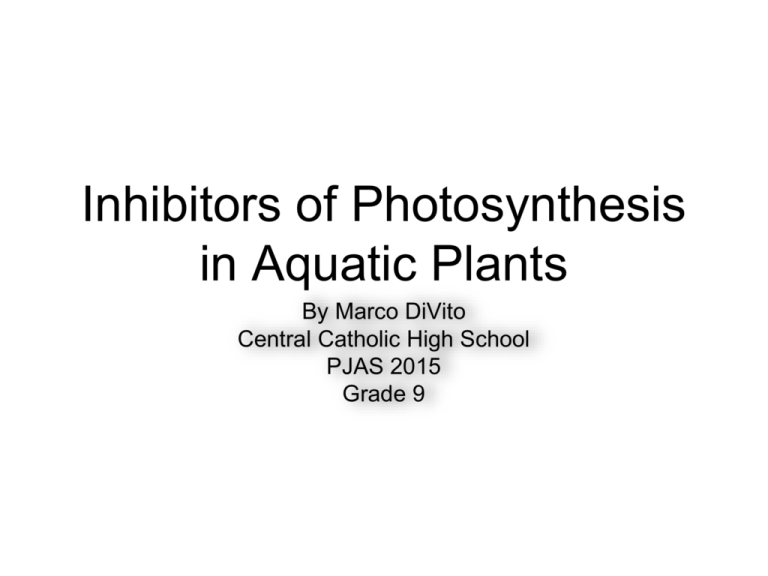
Inhibitors of Photosynthesis in Aquatic Plants By Marco DiVito Central Catholic High School PJAS 2015 Grade 9 Runoff • One of the largest and fastest growing threats to global water resources. • Typical materials transported: fertilizers, petroleum, pesticides, herbicides, and salts. • Runoff often leads to a disruption of aquatic ecosystems. • Rainwater collects and carries chemicals into lakes or streams, possibly causing eutrophication or toxicity. • Eutrophication results in depletion of oxygen in the water, killing off many other species. Herbicide • Bentazon-benzothiadiazinone group • This group is designed to inhibit photosynthesis • Cause of selectivity not been discovered • Shown to be effective against cocklebur, smartweed, and ragweed. Chloroplasts • Photosynthesis occurs in chloroplasts, which are double membrane bound organelles found in plant cells • Thylakoid membrane suspended in the stroma • Photosystem 1 (PSI) and Photosystem 2 (PSII)reaction centers responsible for turning light energy into chemical energy Photosynthesis • Chloroplasts contain the pigment molecule chlorophyll • Light excites chlorophyll electrons • Energy transfer-redox reactions drive synthesis of ATP and NADPH Photosynthesis • PSI releases NADPH directly into the stroma • Electron flow results in H+ transfer through thylakoid lumen • H+ pumping powers ATP synthase Elodea • Elodea Canadensis • Also known as American waterweed • Commonly used in aquariums • Can function as a habitat, shelter, or food source in aquatic ecosystems Purpose • The purpose of this experiment is to determine the effects of a herbicide designed to inhibit photosynthesis on a non-target aquatic plant • This and other plants could be exposed to the herbicide via runoff from nearby fields • Photosynthesis will be quantified by the amount of dissolved oxygen in sealed tubes at the beginning and end of the trials Hypothesis • Null: the herbicide bentazon will not significantly inhibit dissolved oxygen production by elodea • Alternative: bentazon will reduce the dissolved oxygen produced by the elodea Materials • Basagran Herbicide (contains active ingredient bentazon) • 20 150mm x 25mm test tubes with rubber stoppers • 20 stalks of Elodea Canadensis • DO probe (Sper Scientific probe pen) • Micropipettes and pipette tips • Water • Test tube racks • Floodlights (75 watt) • Scissors Stock Concentrations 0% 0.01% 0.1% 1% Herbicide (44% bentazon) 0uL 11uL 114uL 1136uL Water 50,000uL 49989uL 49886uL 48864uL Total Volume 50,000uL 50,000uL 50,000uL 50,000uL Procedure 1. Cut twenty 6 centimeter segments of Elodea Canadensis and inserted one into each test tube 2. Made large quantities of stock solutions for bentazon. 3. Added 50mL of fluid to each test tube, with five tubes for each concentration. 4. Allow fluid in tubes to settle and reach a stable DO concentration 5. Measured the dissolved oxygen in each tube 6. Inserted one segment of elodea into each tube, then sealed the tubes with the stoppers. 7. Set up floodlights facing tubes and waited 12 hours 8. Measured the dissolved oxygen in each tube DO- Initial Tube 1 Tube 2 Tube 3 Tube 4 Tube 5 20mg/L P-value: 0.99 Dissolved Oxygen 15mg/L 10mg/L 5mg/L 0mg/L 0% 0.01% 0.1% Concentrations of bentazon 1% DO- Final Values (After 12 Hours) Tube 1 Tube 2 Tube 3 Tube 4 Tube 5 20mg/L P-value: 7.55E-07 Dissolved oxygen 15mg/L 10mg/L 5mg/L 0mg/L 0% 0.01% 0.1% Concentrations of bentazon 1% Analysis: Dunnett's Test (Final Values) T-crit: 3.48 T-Value Interpretation 0.01% 4.94 Significant 0.1% 6.74 Significant 1% 9.23 Significant DO Changes 70% 59% P-value= 1.56E-06 Percent Change 35% 0% -10% -32% -35% -69% -70% -105% 0% 0.01% 0.1% Concentrations of Bentazon 1% Analysis- Dunnett's Test (Changes) T-crit: 3.48 Tests T-value Interpretation 0.01% 4.93 Significant 0.1% 6.26 Significant 1% 8.79 Significant Key Questions • Does the herbicide bentazon inhibit photosynthesis? • P-value<0.05- Yes • Do varying concentrations produce different effects? • T-values of 4.93, 6.26, 8.79 all higher than alpha of 3.48- Yes-increasing concentrations have increased effect Conclusion • Null Hypothesis: bentazon will not inhibit dissolved oxygen production • Reject null hypothesis for experiment • Accept alternate hypothesis Limitations and Extensions Limitations • Mixing could have affected DO • One herbicide used • Limited concentrations used • Window-variable light source • • Possible temperature fluctuation Ingredients in water Extensions • Different environmental conditions (temperature, amount of light, natural substances in water) • Different types of herbicides (photosynthesis inhibiting and not) • Combinations of herbicides • Test synergistic effect of fertilizers • Different range of concentrations • Longer exposure times • Different model • Different ways to quantify photosynthesis Works Cited • "Cytochrome Complex in Electron Transport." Hyperphysics. N.p., n.d. Web. 27 Dec. 2014. • "Elodea Canadensis (common Waterweed) and Elodea Nuttallii (Nuttall's Waterweed)." Elodea Canadensis (common Waterweed) and Elodea Nuttallii (Nuttall's Waterweed). Washington Department of Ecology, n.d. Web. 01 Jan. 2015. • Gibson, Lance R. "Photosynthesis Inhibitors." Agronomy 317. Iowa State University, 23 July 2004. Web. 20 Dec. 2014. • "Herbicides - Weed Management (Penn State Extension)." Weed Management (Penn State Extension). Penn State University, n.d. Web. 23 Dec. 2014. • "Native Freshwater Plants." - American Waterweed. Washington State Department of Ecology, n.d. Web. 23 Dec. 2014.
